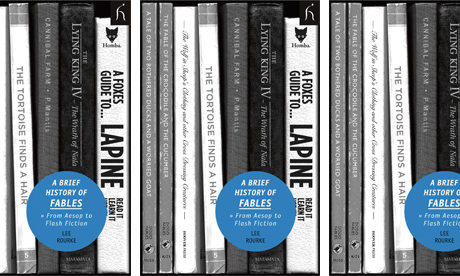A Brief History of Fables: From Aesop to Flash Fiction – review

It is impossible to be a writer these days without taking inspiration from literary journals published from the bedrooms of complete unknowns, or beat novels compiled from ramblings scribbled on the backs of fag packets, or even the primitive oral storytelling traditions of days of yore.
There are good reasons why democratic, unpretentious, grassroots literature of this ilk is enjoying a comeback.
The world of conventional publishing is so inaccessible to most aspiring novelists that many must cultivate an appreciation of obscure fanzines and spoken word nights, if for no other reason than that the existence of such forums offers new writers a fighting chance of airing their work.
But there’s another reason why the latest doorstopper by a mainstream author is unlikely to be considered de rigueur by the true 21st century literary connoisseur: it is too long.
In this age of the internet, iPhones and other iThings, brevity is key.
According to leading light of the east London fiction scene Lee Rourke, this helps explain the revival of a very old literary form: the fable.
Fables, Rourke reminds us, are snappy ‘microfictions.’ They have traditionally featured animals with perceived human characteristics such as the cunning fox or the haughty eagle.
Some even feature plants or inanimate objects as characters. In the case of one contemporary example highlighted by Rourke, the month of February is anthropomorphised in this way.
Fables have a quintessentially earthy feel, derived as the form is from folk literature, and many possesses a healthy dose of populist humour.
Aesop’s classics, such as ‘The Boy Who Cried Wolf’ and ‘The Tortoise and the Hare’, were simple tales that had at their heart a moral that was easily understandable by all.
You don’t need to be a literary critic or even a grown-up to ‘get’ the moral: it’s fairly obvious.
Aesop was spinning his snappy yarns thousands of years ago in ancient Greece but, as Rourke demonstrates, later fabulists have injected a devilishly playful subtlety into the form.
Hackney resident Rourke, who is co-editor of avant-garde online literary magazine 3AM and best known for his 2010 short novel The Canal, rattles through Rumi, Kafka and James Joyce, finishing up at the present day with contemporary fabulists HP Tinker and Shane Jones and the jaunty flash fictions popular online.
“In an ever-more digitised world of mobile snippets of content to be devoured where and when we choose in the palms of our hands, flash fiction seems to have found its small place amongst the rising tide of technological innovations,” Rourke declares.
At each stage of the game, the author sets the fictions he discusses in their social and historical context, allowing readers to understand them in a new light.
A Brief History of Fables, part of an elegantly produced series that includes A Brief History of Diaries and A Brief History of Encyclopaedias, aims to signpost readers to works they might otherwise have overlooked.
It is an accessible take on an accessible form, and with his roots in what might be considered literature’s equivalent of theatre’s Fringe or ‘Off-Off-Broadway’ sectors, Rourke is an apt choice of guide.
A Brief History of Fables: From Aesop to Flash Fiction
By Lee Rourke
Published by Hesperus Press
Price: £8.99.
